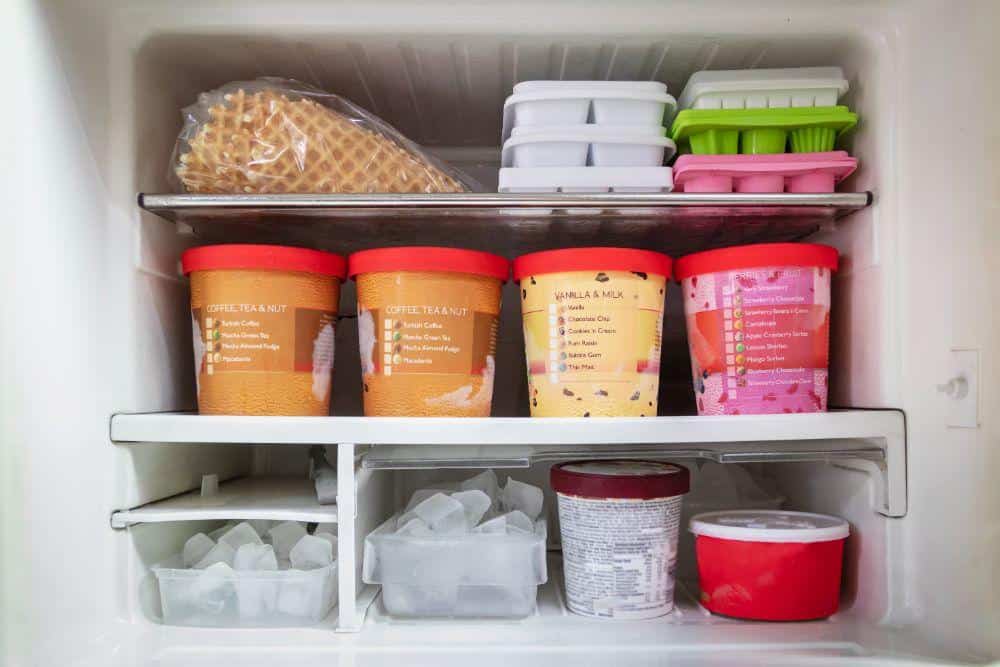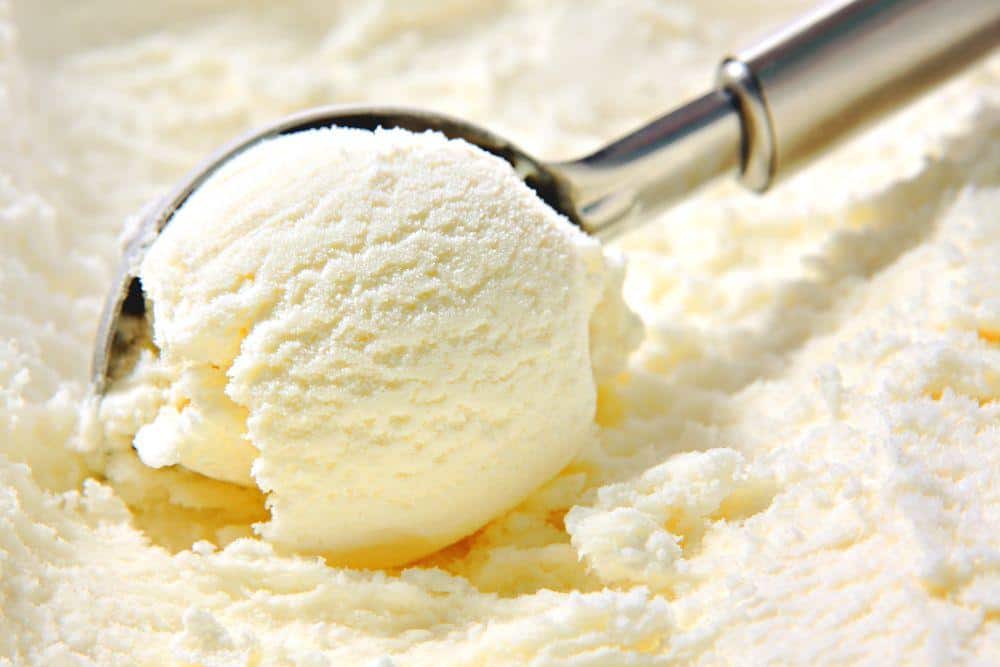When it comes to storing your frosty indulgence, it's essential to adhere to the guidelines specified by your ice cream maker. Manufacturers formulate these instructions based on a thorough understanding of their product's composition and the optimal conditions to maintain its quality.
Typically, these experts advocate for storing ice cream at temperatures ranging from -5°F to 0°F. So, the ideal freezer temperature for storing ice cream is just below zero degrees Fahrenheit. At these temperatures, your ice cream stays frozen, preserving its texture and taste. Too warm, and you risk a melted ice cream mess. Too cold, and your ice cream can become frustratingly rock-hard and lose its smooth, creamy quality.
Hopefully, your freezer has a digital thermostat so that you can lock in the ideal temperature to maintain the quality of your ice cream. If you have an older or less “tech” freezer that uses a dial for temperature control instead of a digital thermostat, consider buying a freezer thermometer so that you can dial in the correct temperature for your frozen treat. 
Use Your Freezer’s Thermostat to Set Your Freezer to the Proper Temperature: Between 0 and -5 Degrees Fahrenheit
But remember, consistency is crucial. Frequent fluctuations in temperature can lead to unwanted ice crystal formation, detracting from your ice cream's delightful creaminess. So try to avoid the temptation of taking out the ice cream, leaving it out, then refreezing it.
In a nutshell, take the time to understand and implement your ice cream maker's storage instructions. By doing so, you ensure each spoonful of your frozen dessert delivers the delectable experience you crave!
Temperature vs. Texture
For a delightful ice cream experience, ensure it's soft enough to scoop and not too hard or runny. Aim to serve it within the 5-10°F temperature range for an exquisite taste. By maintaining these parameters, your taste buds are in for a treat!
If you're looking to store it for a longer period, however, it needs colder temperatures. Preserve your ice cream under 0°F to retain its delightful appeal for future indulgences. Although it might seem unappealing hard at these temperatures, trust us, the consistency is perfect for storage!
Supermarket refrigerator and freezer sections must maintain temperatures at or below 10°F to prevent the ice cream from melting. If it's too hard, allow your ice cream masterpiece to slightly warm up before you indulge. Your spoon, and surely your palate, will be grateful!
Looking to amaze your visitors with flawlessly scooped ice cream? Begin by slightly thawing your chilly delicacy. Approximately 10-30 minutes out of the freezer before serving should do the trick. But of course, that still depends on your container’s size and the hardness of the treat. You need to check it from time-to-time. So be attentive! A delay beyond 5 minutes may cause an unwanted melting fiasco, and who would want that, right?
To attain a scoopable consistency, target a serving temperature of about 5°F to 10°F. This temperature range will mitigate ice crystal formation and combat the undesirable hardness, making the ice cream scoop-ready and satisfying.

Let Your Ice Cream Sit in the Container for a Few Minutes to a Slightly Warmer Temperature to Make Scooping and Serving Easier
Now that your ice cream has been slightly thawed, it's time to conquer the technique of professional scooping. Equip yourself with a reliable ice cream scooper and a cup of water at room temperature. The purpose of the water? It's simple! Moistening your scooper aids in smoother, quicker release of the ice cream.
With your moistened, reliable scooper at the ready, apply a firm pressure into the ice cream and scoop out servings in the traditional, rounded ice cream shape. Voila! You're now an ice cream scooping maestro!

Adding a Little Bit of Water to the Ice Cream Scoop Can Soften the Ice Cream’s Surface and Make Serving Easier
Keep in mind, the conditions of your freezer and the preparation for scooping can make a world of difference. Now, march forward and serve up those impeccable scoops of ice cream!
Hiland Dairy recommends waiting around 5 Minutes Before Attempting to Serve Ice Cream
When it comes to ice cream, you can't just toss it in the freezer and hope for the best. Let's dive into some cool storage solutions for keeping your frozen treats in tip-top shape.
It's time to say goodbye to the less durable cardboard boxes that your frozen treat originally comes in. These boxes may be practical for transport and sale, but they fall short when it comes to freezing and preserving the quality of your ice cream at home.
The key to maintaining that just-bought freshness (or even fresher homemade ice cream quality) lies in your choice of storage vessel. We highly recommend switching to sturdy plastic containers with airtight lids. The hardy material of these containers offers superior insulation, and the airtight lid is a must-have feature. Not only does this prevent freezer burn by keeping out the cold, dry air of your freezer, it also stops the ice cream from absorbing other flavors floating around in there.
Furthermore, the clear plastic allows you to easily identify the flavor inside, saving you from the 'mystery scoop' predicament. It also makes it easier to spot when you're running low and it's time to restock!
So, for the sake of your ice cream's taste and texture, it's time to upgrade to plastic containers with airtight lids. Trust us, your taste buds will thank you!
Freezer burn is indeed the icy nemesis that threatens the lush, creamy perfection of your ice cream. However, there's no need for despair! With a little careful preparation, you can keep this frosty foe at bay.
Start by wrapping your ice cream container securely in a layer of plastic wrap. This initial layer creates a seal that helps to prevent the exchange of moisture between your ice cream and the freezer environment, a major cause of freezer burn.
Once you've got your ice cream snuggly encased in plastic wrap, take it a step further by placing the whole package into a freezer bag. This second layer provides an additional level of insulation, further shielding your precious ice cream from the harsh, dry air of the freezer.
Remember to squeeze out as much air as possible from the freezer bag before sealing it. The less air in the bag, the less chance there is for moisture to escape from your ice cream, reducing the risk of those dreaded ice crystals forming.
This dual protection approach, incorporating both plastic wrap and a freezer bag, is your secret weapon in the fight against freezer burn. By keeping the cold, dry air at bay, you help to preserve the smooth, creamy texture and rich flavor of your ice cream. Enjoy every scoop as good as the first with this simple storage solution!
It's time to talk about temps. Crank your freezer down to below 0°F (-18°C) to give your ice cream a cozy home. Consistent temperatures are key; no fluctuating freezes allowed here! A cold environment reduces the risk of freezer burn and maintains the perfect texture for your scoopable delight.
Armed with these nifty tricks, your ice cream storage game will be on point. Say goodbye to freezer burn and hello to tasty, creamy excellence!
Prepare yourselves for an exhilarating journey through the world of luscious frozen desserts. We're about to delve into a trio of delicious delights - gelato, sorbet, and custard - guaranteed to send your taste buds on an unforgettable flavor voyage!
You must try gelato, a tasty Italian cousin of ice cream. With less fat and air, it's denser, creamier, and richer in flavor. Don't forget, you'll find it served at slightly warmer temps than ice cream, so say "ciao" to your chilled treat's hearty, full taste!
Feeling fruity? Your go-to choice should be sorbet! This colorful frozen treat is a dairy-free delight made from fruit, sugar, and water. Not only is it bliss for your senses, but it's also a lighter, more refreshing option. Sorbet is a great palate cleanser, so enjoy it between meals if you're feeling fancy.
Rich, smooth, and delightful - who wouldn't love frozen custard? This treat is like ice cream, but with a delightful twist: egg yolks! These gems give it an ultra-creamy, velvety texture that'll have you savoring every spoonful. So, indulge in this decadent dessert the next time you're craving a frozen delight!
When you're stocking your freezer with your favorite frozen desserts, don't forget to keep them at their optimal temperatures. This way, you can treat yourself to the ultimate frozen experience, whether it's gelato, sorbet, or custard!
To scoop your frosty treat like a pro, aim for a serving temperature between 5°F to 10°F. Isn't that cool? Just remember, the ideal scoopable ice cream is right when it is at that sweet spot.
Uh-oh! At 32 degrees, your ice cream won't be frozen solid. For truly solid storage, set your freezer to between -5°F and 0°F. That's the magic range to prevent your ice cream from turning into a soupy mess.
Want to keep your ice cream as cold as your ex's heart? Use an airtight container with a tight-fitting lid. You'll shield your sweet treasure from freezer burn and funky smells. Also, use materials with insulating properties, like foam or waxed paper if possible.
Keep it cool: Store your ice cream in the main part of the freezer, not the door.
Be cozy: Wrap the container in a plastic or reusable bag. It's like a snuggie for your dessert!
Reduce air exposure: Press a piece of parchment or wax paper on the ice cream’s surface before closing the lid. Your ice cream will thank you!
